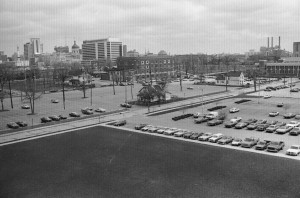
In April, 1980 the home at 725 West vermont Street sat in the center of this picture of the IUPUI campus. 311 Bright Street stood just to its south at the right side of the image (click for larger image).
In 1874 the first residents moved into 311 Bright Street in Indianapolis’ near-Westside. The modest frame house sat in the midst of a neighborhood that rapidly emerged after the Civil War. It sat across the street from Garden Baptist Church, which opened in 1872, alongside 36 houses in the two blocks between New York and Michigan Streets.
The same year the house was built on Bright Street Ira Johnson was born in Cassville, Georgia. Johnson, his wife Lillian, and their 13 children worked on farms in and around Bartow County, Georgia for more than 50 years. Lillian died in 1923, and in about 1930 Ira Johnson moved to Indianapolis. In 1944–75 years after the home at 311 Bright Street was built–Johnson moved into it.
By the time of his death in December, 1974, the 100-year-old Johnson was one of the last residents of Bright Street. The neighborhood had been depopulated after 1960 by Indiana University as it acquired the property that eventually became the campus of Indiana University-Purdue University, Indianapolis (IUPUI).
In April, 1980 a photograph of Indianapolis’ near-Westside captured the neighborhood’s final moments as it transitioned from a residential community to a University campus. Two residences resolutely sat in the midst of parking lots built up to their fences’ edges, including the home at 311 Bright Street where Ira Johnson’s daughter Marie Johnson continued to live until 1982. The image is a stark testament to the material and social disintegration wrought by urban renewal, and Johnson’s experience of displacement reflects the dissension that has accompanied community displacement and the growth of postwar urban universities.
Johnson’s 1974 obituary took clear aim on how University expansion had unsettled Ira Johnson’s final years. The Indianapolis Recorder obituary suggested that in the 1960s the elderly Johnson realized “there was no longer the need to hustle and bustle around so he spent hours sitting on his porch at 311 Bright. This too had to come to an end. So many strange things began to happen. He didn’t like what he heard and saw. His family understood that all the activity was necessary for the building of the new Indiana University-Purdue University at Indianapolis (IUPUI) Law School. He did not. He did not like the noise, the machinery or the people moving about. So he refused to sit on the porch and watch progress. He liked it even less when a parking lot came up to his back fence. The house offered him security and comfort, so his last days were spent in his home, his last hours in his chair. As he sat there, he entered into eternal sleep.”
At the center of the 1980 image was the home at 725 West Vermont Street. The house first appeared in the Indianapolis City Directory in 1865, when it was home to carpenter Jacob Rhinehold, his wife Sarah, son John, and their daughter Emma. Jacob Rhinehold was born in Pennsylvania in about 1818 and was farming in Franklin, Indiana on the eve of the Civil War. The Rhineholds came to Indianapolis after the war, and Sarah lived on Vermont Street through the deaths of John in 1879, Emma in 1883, and Jacob in 1884. She married John Abbett in 1892, and around 1900 they moved into a house that had just been built in their Vermont Street back yard (numbered 317 Bright Street on the map at right). Sarah and John Abbett rented the property on Bright Street and continued to live there through John’s death in 1903. Sarah remained in the house until her own death in May, 1906.
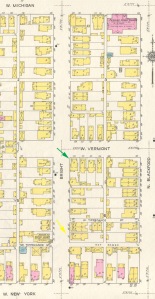
In 1915 725 West Vermont Street stood at the green arrow on this map and 311 Bright Street was at the yellow arrow. Other features on the map included Garden Baptist Church, which sat across the street from 311 Bright Street from 1872 until 1941(click for a full-size image).
The neighborhood was overwhelmingly home to White Hoosiers into the early 20th century, but there was always some ethnic and color line diversity, and the demography varied quite a lot just blocks away. In 1900, for instance, 332 people lived in the four blocks just one block east of Bright Street, a neighborhood that was bordered by Blackford, North, California, and Michigan Streets. Those 332 residents included just 14 European immigrants (11 from Germany, two from Scotland, and one from England). While Bright Street would have very few Black residents before 1920, in 1900 167 of the 332 Blackford Street residents were Black; nearly all were on the north side of Michigan Street along North and California Streets, just blocks from Indiana Avenue and the heart of the city’s African-American business and leisure district. In contrast, on the south side of New York Street a very tightly packed neighborhood bordered by Douglass, New York, Blake, and West Market Streets had 345 residents in 1900, of whom 49 were born in Ireland and 16 were German immigrants. Many of those Irish residents and their American-born families worked at Kingan and Company meat packing plant, but just 10 of the 345 residents were identified in the census as Black; in 1920, not a single Black resident lived among the 501 residents in the same neighborhood.
In 1900 only one African-American household was living in the houses surrounding 725 West Vermont, when Alexander and Belle Kelly were living at 715 West Vermont Street. The first African-American resident at 725 West Vermont did not come until 1924, when James and Fannie Maxwell purchased the home. James Maxwell was born in North Carolina and worked for the railroad, moving between Indianapolis and North Carolina until his death in North Carolina in March, 1941. The home at 311 Bright Street first appeared in the city directory in 1874, but its first African-American residents did not come until 1940, when John and Emma McNeary moved into the home.
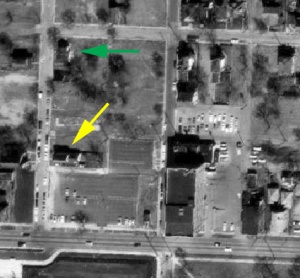
In this 1972 aerial view, 725 West Vermont Street is at the green arrow and 311 Bright Street is the yellow arrow.
Indiana University had acquired modest tracts of property around the Medical Center since the 1920s, and in 1956 two urban renewal projects alongside the University Medical Center cleared 18 and 19 acres respectively. However, the campus’ most significant growth would not come until the 1960s. Robert and Lola Morgan may not have recognized that the University’s expansion threatened their new home when they moved to 725 West Vermont Street in 1960 with their son Milton. The Morgans were living in Helena, Alabama in 1940 and moved to Indianapolis after the war, where Robert worked as a plumber in the stockyards. Milton graduated from Crispus Attucks High School in 1965 and continued to live in the Vermont Street home until 1979, moving just before the 1980 photograph of his home engulfed by IUPUI parking lots.
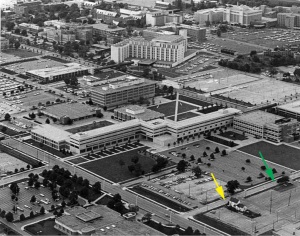
This 1982 aerial view shows 311 Bright Street still standing at the yellow arrow. The home at 725 West Vermont Street had been razed, which is reflected in the fresh asphalt patch at the green arrow.
Urban renewal images often portrayed massive demolition and displacement, but the depopulation of the IUPUI campus was a somewhat more gradual process. The Federal Housing Act was amended in 1959 directing federal aid for “urban renewal areas involving colleges and universities,” unleashing growth by a host of urban universities and igniting the development of many new city campuses. Indiana University had its eye on those federal funds, but in the early 1960s, Indianapolis and its influential Chamber of Commerce surprised the University by rejecting federal urban renewal financing (for details, see my 2011 piece with Lewis C. Jones Race, Displacement, and Twentieth-Century University Landscapes: An Archaeology of Urban Renewal and Urban Universities). By about 1964, the University was compelled to begin purchasing individual properties, slowly piecing together the present-day IUPUI campus in single parcels (between July, 1964 and August 1966, for example, the University purchased 401 parcels). In cases where rental households did not want to move after the sale of their home the University would maintain the property and serve as landlords until the household decided to leave; afterward, the home would be torn down, slowly opening the space that became the IUPUI campus. It may be that Ira Howard’s daughter Marie Johnson was renting from the University until 1982 and resisted moving, but when she vacated 311 Bright Street in 1982 she was the last household anywhere near that edge of campus. Today Bright and Vermont Streets have been erased, sitting just east of the present-day University Library.
The University routinely prides itself that it exercised eminent domain in just three or four cases, but this of course did not eliminate ill will on the part of some displaced residents like Ira Johnson, who “refused to sit on the porch and watch progress. He liked it even less when a parking lot came up to his back fence. The house offered him security and comfort, so his last days were spent in his home, his last hours in his chair.” In March, 1977 Robert DeFrantz complained in the Indianapolis Recorder that “there was a time when IUPUI expressed concern for the community. . . . Now they do not even bother. If IUPUI was really interested in the community, then they would make available to the community all those resources they have at their hands. IUPUI would be helping develop an economic base for Afro-Americans, or include representatives of their trustee board from the neighborhood, or at least what is left of the neighborhood. In other words, if IUPUI was for real, they would see that the community was getting part of the action. Instead, they are doing everything they can to freeze them out.” A month later DeFrantz lamented that “if IUPUI had any real commitment to people, they would be helping community groups plan with all the resources that IUPUI has at its command. The only commitment IUPUI really has is to wipe out the Afro American presence that surrounds it.” The 1980 photograph reminds us of many of those sentiments may appear erased by the University today sitting in that space, but they remain at heart of the story of postwar urban campus growth in Indianapolis and many more American cities.
Source
Paul R. Mullins and Lewis C. Jones
2011 Race, Displacement, and Twentieth-Century University Landscapes: An Archaeology of Urban Renewal and Urban Universities. In The Materiality of Freedom: Archaeologies of Postemancipation Life, ed. Jodi A. Barnes, pp.250-262. University of South Carolina Press, Charleston.
Images
Aerial view of IUPUI looking northwest, 1982 image from IUPUI University Library Special Collections and Archives
House at 725 W. Vermont Street, 1980 image from IUPUI University Library Special Collections and Archives
Sanborn insurance map images from 1898 and 1915 from IUPUI University Library Special Collections and Archives
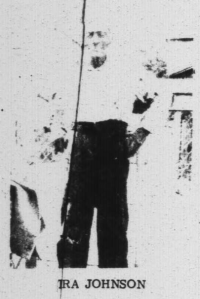
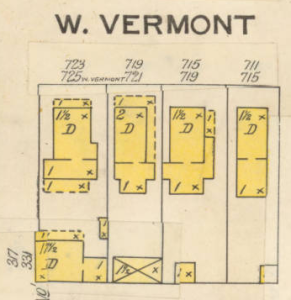
Reblogged this on Archaeology and Material Culture and commented:
Some readers interested in post-war urban displacement, race, and Indianapolis histories may be interested in this piece from the Invisible Indianapolis blog.
LikeLiked by 1 person
Pingback: Interchange – The Mask of the Public Good: What the University Costs Communities – WFHB